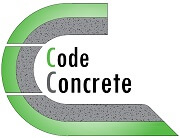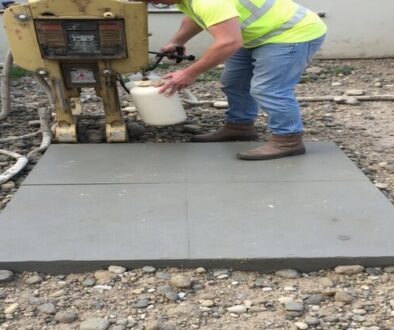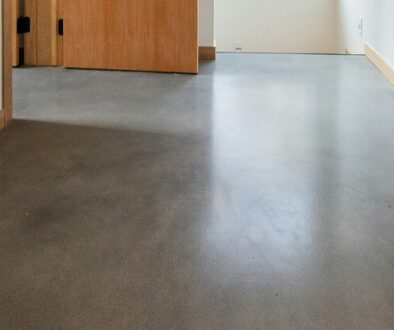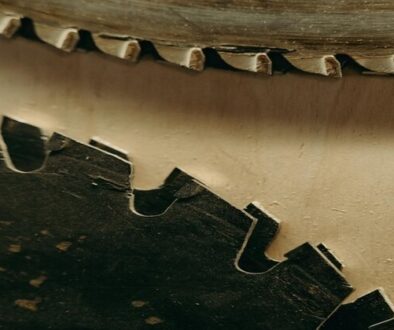What is Concrete Grinding and How Does It Work?
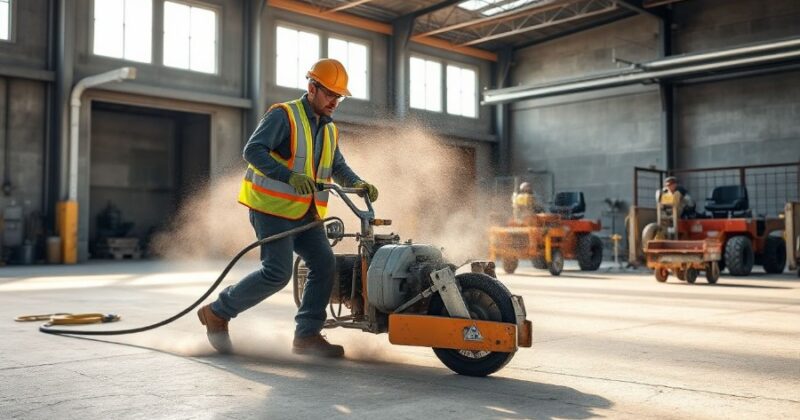
Last updated on July 19th, 2025
Concrete grinding is a vital part of many construction, renovation, and flooring projects. It’s the process that transforms rough, uneven surfaces into smooth, level, and attractive floors. Whether you’re upgrading a home garage or preparing a commercial space, concrete grinding plays a key role in achieving professional results.
Did you know that the global market for concrete grinding services is expected to grow significantly over the next few years? As more property owners and contractors realize the benefits, demand for reliable techniques and powerful tools increases. This article aims to give you a full understanding of concrete grinding. You’ll learn about the best techniques, essential equipment, safety tips, and what to consider budget-wise before starting your project.
What Is Concrete Grinding?

Concrete grinding is a process used to smooth and level concrete surfaces. It involves the use of specialized machines equipped with diamond-embedded disks or blades. Unlike surface treatments such as polishing or etching, grinding removes a thin layer of concrete to fix imperfections or prepare the surface for further coatings.
Imagine it as sanding wood — but on a much larger and tougher surface. The goal is to eliminate rough patches, paint, epoxy residues, or surface scratches so that the surface becomes perfectly even and clean.
Common Applications
Concrete grinding isn’t just about aesthetic upgrades; it’s a practical solution for many situations:
- Surface leveling for new constructions or renovations where the floor isn’t perfectly flat.
- Floor polishing to add sheen and make spaces more appealing.
- Removing paint, epoxy coatings, or surface imperfections to prepare for new finishes or repairs.
Benefits of Concrete Grinding
Concrete grinding offers numerous advantages that enhance both the appearance and functionality of surfaces. This process effectively removes imperfections, such as stains and unevenness, resulting in a smoother and more aesthetically pleasing finish.
Additionally, grinding increases the durability of concrete by eliminating weak spots and preparing the surface for further treatments, such as sealing or polishing. It also improves safety by reducing slip hazards, making it an ideal choice for both residential and commercial spaces. Overall, concrete grinding is a valuable investment that contributes to the longevity and visual appeal of concrete surfaces.
Why is concrete grinding becoming so popular? Here are some solid reasons:
- It boosts the durability and slip resistance of floors, making them safer.
- It creates a smooth, polished surface that enhances visual appeal.
- It cuts down on costs and saves time during surface prep, especially when compared to more invasive methods.
Types of Concrete Grinding Techniques and Methods
Surface Preparation Grinding
Before applying coatings, repairs, or sealants, you need a clean, even surface. Surface preparation grinding tackles rough patches and unevenness, creating a solid base. Typically, rough grinding uses coarse diamond abrasives to remove bumps or old coatings efficiently.
Polishing Concrete

Want that high-gloss, mirror-like finish? Multi-stage polishing is the way to go. It starts with a coarse grit and moves to finer ones, progressively refining the surface. This process not only improves appearance but also hardens the concrete, making it more resistant to stains and wear.
Leveling and Flatness Correction
Uneven or warped slabs pose challenges for any project. Leveling techniques involve grinding down high spots or filling low areas. Regulations like the FAA’s floor flatness standards help define what’s acceptable in commercial spaces. Achieving these standards involves careful planning and multiple passes to ensure a perfectly flat floor.
Concrete Scarification

Scarification is a more aggressive approach than regular grinding. It’s used to remove thick coatings — especially when other methods wouldn’t suffice. Think of it as a rough, deep cut to get rid of stubborn layers. While it produces a rougher finish, it’s excellent for preparing large areas quickly.
Expert Tips for Choosing the Right Technique

Selecting the best method depends on your project’s needs:
- How rough or damaged is the surface?
- What kind of finish do you want?
- Is the primary goal leveling, polishing, or removing coatings? Understanding these factors helps you pick the appropriate technique and equipment.
Essential Equipment and Tools for Concrete Grinding
Handheld and Portable Grinders

Small projects or tight spaces call for handheld tools like angle grinders. They’re perfect for small patches or finishing touches but aren’t ideal for large areas. These grinders are lightweight and flexible but limited in grinding power.
Walk-behind Floor Grinders

For bigger spaces, walk-behind models are the norm. They come with one or two grinding heads, making surface prep faster. Single-head machines work well for residential jobs, while dual-head models are better suited for commercial flooring projects.
Diamond Abrasive Discs and Tools

Diamond discs are the heart of concrete grinding. They come bonded with either metal or resin:
- Metal-bonded diamonds last longer and are good for aggressive grinding.
- Resin-bonded diamonds produce finer finishes, ideal for polishing. Choosing the right grit depends on your task; coarser grit removes material faster, finer grit smooths the surface.
Additional Equipment
Dust can be a major issue, so consider investing in dust collection systems. These attach to your grinder to trap debris, keeping the workspace clean and safe. Don’t forget PPE—wear respirators, safety goggles, gloves, and hearing protection to prevent accidents.
Maintenance and Safety of Equipment
Proper maintenance is crucial. Regularly check for wear and tear on disks, and keep tools clean. Always follow safety protocols to avoid injuries, especially when working with high-speed machinery.
Step-by-Step Guide to Performing Concrete Grinding
Preparing the Site
Start by clearing the area of furniture or obstacles. Cover nearby surfaces to protect them from dust and debris. If the concrete is dusty or porous, moistening it beforehand helps the grinding process and prevents excessive dust.
Selecting the Right Equipment and Discs
Match your tools to the project’s size and finish goals. For example, use a coarse grit diamond disc for initial leveling, then switch to fine grit for polishing. Choosing the wrong abrasive can slow down progress or damage the surface.
Conducting the Grinding Process
Begin with coarse grit — typically 30 or 40 — to remove rough patches or high spots. Overlap each pass to ensure even coverage. Gradually switch to finer grits, like 80 or 120, to refine the surface. This progressive approach ensures a smooth, uniform finish.
Managing Dust and Debris
Attach dust extractors to your grinder wherever possible. Regularly clean debris from the work area. Proper disposal of waste not only keeps the site tidy but also prevents breathing hazards.
Final Finishing and Polishing
Once grinding is complete, apply sealants or coatings based on your goal. For a high-gloss look, optional polishing steps with finer abrasives or stain guards can give your surface a professional shimmer.
Troubleshooting Common Issues
Uneven surfaces or deep scratches happen if the process isn’t carefully monitored. Burn marks or discoloration can occur from improper grinding speeds or dirty discs. Adjust your technique accordingly to fix these problems.
Safety Considerations and Best Practices
Personal Protective Equipment
Always protect yourself with gear like respirators to avoid inhaling dust, goggles for eye safety, gloves for hand protection, and ear plugs or muffs to guard against noise.
Proper Ventilation and Dust Control
Using dust collection systems is essential for safety and health. Ensure your workspace has good airflow and proper filters. Dust particles can cause respiratory issues over time.
Handling and Storage of Equipment and Chemicals
Store abrasives, chemicals, and chemicals safely away from children and pets. Keep tools clean and well-maintained to ensure longevity and performance.
Training and Certification
Only trained operators should handle powerful grinding equipment. Certified courses teach safe operation and proper techniques, which helps prevent accidents and ensures quality work.
Cost Factors and Budgeting for Concrete Grinding Projects
Factors Influencing Cost
Size and complexity heavily impact cost. Larger or more intricate surfaces take longer and require more materials. Renting equipment can be cheaper for small projects, but professional tools often give better results.
Estimating Project Costs
For average residential projects, expect to pay roughly $1 to $3 per square foot. Commercial jobs may cost more due to complexity and equipment. Always get quotes from multiple vendors to compare.
Cost-saving Tips and Pitfalls to Avoid
- Rent equipment instead of buying if only needed temporarily.
- Order the correct abrasive grit in bulk for discounts.
- Avoid cutting corners, as cheap equipment or chemicals can ruin your finish and lead to costly repairs.
When Should You Hire Professionals?
For large or complicated jobs, hiring seasoned contractors is often the smarter choice. Experienced professionals guarantee safety, efficiency, and quality that’s hard to match with DIY methods.
Conclusion
Concrete grinding is a powerful technique that transforms rough surfaces into smooth, beautiful floors. Knowing the right methods, tools, and safety rules ensures quality results and saves money in the long run. Whether you’re a DIY enthusiast or a professional contractor, investing time and resources into proper concrete grinding makes all the difference.
Take your time to plan, choose the right equipment, and follow best practices. For big projects, don’t hesitate to hire experienced pros. With the right approach, your concrete surfaces will last longer, look fantastic, and stand out for years to come.
